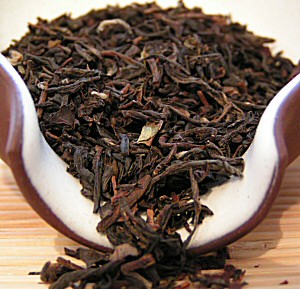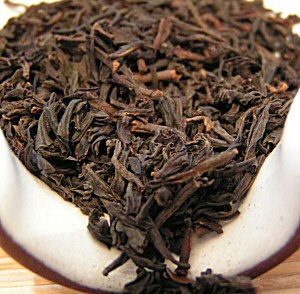Message
Types of Tea
Black Tea Blends - Russian Caravan
Most of teas available nowadays are blends. Some of them are just an attempt to palm off worthless tea mixing it with some small amount of decent tea. However, there are different blends… |
||
| Tea House Russian Caravan Tea. | ||
When I was speaking about pure black teas in one of the previous articles, I did not mention a wonderful and sad quality that they have. Pure, truly pure teas are never the same. Fine black tea from a certain estate and of a certain plucking date may be only once. Next flush, next plucking at the same estate will be different, and in a year absolutely different leaves will grow there. Well, of course, not absolutely different — common features of the tea will stay — but nuances, nuances of taste and flavor, they will change. Not for nothing along with the name of the tea, the name of the estate, the ordinal number of the flush, producers also put the year of the plucking on the pack of tea.
Such hardly noticeable yearly change is great, of course, — every year you get new impressions. But it is great from the point of view of pure art and not efficient satisfaction of daily demand of millions of consumers. When they buy a pack of tea with a certain name, they want to get a certain habitual taste and quality — regardless of the fact how much rain was there at this or that tea-growing region.
Just in an attempt to secure invariable quality of a certain tea, blends were created. It is worth noting that ‘stable quality’ is a subjective category. Stable quality may be anything. It can be just ‘acceptable’, for example. Then tea blend will be optimized by prime cost — it will be a mixture of a small amount of good tea with a greater amount of second-rate tea. Famous in Soviet times, tea ‘so slonom’ (with an elephant image on the label) was an example of such a blend.
There is a very beautiful page in the history of tea blends. Lipton company, in those times when it still was a company, and not a trade mark of Unilever, created a whole set of tea blends, each being made for a certain region in Great Britain — or rather for water in those. And, you know, such tea blends were a success.
The second reason why tea blends are made is a wish to get drinks of new tastes. This very reason resulted in appearance of famous tea blends which will be discussed below. One more remark before I shall begin the story of these blends.
Most teas sold in shops are blends. Unfortunately, they are mostly blends optimized ‘by prime cost’. Even if it says on the pack that it is ‘Pure Ceylon Tea’, it means only that inside there is nothing except Ceylon tea. But Ceylon is a big island with a large number of tea plantations. Every particular consignment of tea of a certain trade mark may be an absolutely unique mixture of teas. There can be tea from good estates but of poorer quality, just good tea, old tea which has lost a bigger part of its flavor — anything, merely not to poison the consumer.
For the sake of justice I would like to notice that respectable producers uphold their reputation — they optimize tea blends not only by cost, but also by quality. Although, they may also have rather different consignments of tea. Thus, for example, two or three years ago I liked Jackson of Piccadilly Russian Caravan Tea much more than now. It seems that along with the package design the owners of Jackson of Piccadilly have changed the composition of this famous blend.
 |
||
| Twinings Russian Caravan Tea. | ||
Ooh… I finally managed to somehow pass from protracted introductory remarks to description of specific black tea blends. I’ll start with the mentioned Russian Caravan.
So. Until the opening of the Suez Canal in 1869 the way of tea from China to Europe had been long and arduous. Tea could be shipped by sea (4 months by water, with an unavoidable loss of quality, from Canton, past India, and round Africa) or by land (about a year, cross Siberia or Middle Asia, European part of Russia, and part of Europe, with a little loss of quality). Most tea reached Europe by sea (such tea was simply called Canton tea). But there were minute amounts of tea — just crumbs — which came through Russia. This tea was called Caravan tea; it was better (first of all more flavored) than Canton tea and therefore it was highly valued. Sometimes, being a precious product, it was blended with ordinary teas.
After the opening of the Suez Canal delivery of tea into Europe by sea became cheaper, and the loss of quality became less noticeable — and Caravan tea from a product with certain characteristics began to turn into marketing myth. By the middle of the 20th century this tea myth-making had been completed — the name ‘Russian Caravan’ was given to a blend whose permanent ingredient is Chinese Keemun tea (sometimes, very seldom — Lapsang Souchong, smoked tea). The presence of China tea in the blend is historically conditioned — Caravan tea was coming from China indeed. All other components of the blend can be anything — whatever the producer prefers.
Very often on the pack of Russian Caravan there is an image of a camel (a hint at Middle Asia and the fact that part of the way tea made on these phlegmatic animals) and a story which says that this very tea was extremely popular among Russian aristocracy. And that is a doubtful point already — no doubt that Russian aristocracy did drink China tea (there was simply no other tea), but it was absolutely different from the one blended in Russian Caravan. Moreover, tea which had the word ‘Russian’ in its name was long unknown and unavailable in Russia.
Nowadays in the shops you can find ‘Russian Caravan’ of Jackson of Piccadilly and Twinings, abroad the choice is wider — but quality and taste of all these blends are about the same. They have somewhat dry roughly-flowery flavor (it is such a terrible torment to define tastes and flavors by words), light, barely sweet taste and wonderful, divine dry and shaggy aftertaste. Because of this very aftertaste ‘Russian Caravan’ is better drunk pure — without sugar, cream, lemon, or any other stuff (although, on the pack, they will say that the tea is good with milk and lemon). This tea goes well with crème pastry and pies as well as with classic tea snacks: oatmeal cookies, cucumbers/ham/salmon/cheese sandwiches, and other nice things.
To moderate raptures a little, I’ll get back to the remark made above: two or three years ago I liked Jackson of Piccadilly Russian Caravan Tea much more than now. The whole year I was enchanted with this tea. Now I just like it. Perhaps, I have got used to it, but it is not improbable that the composition of the blend has changed.
‘Russian Caravan’ may be ascribed to afternoon (lunch) teas or to evening teas. It can be a perfect digestive as a finishing note of a rich meal. Its compatibility with all kinds of snacks has been already described.
Denis Shumakov